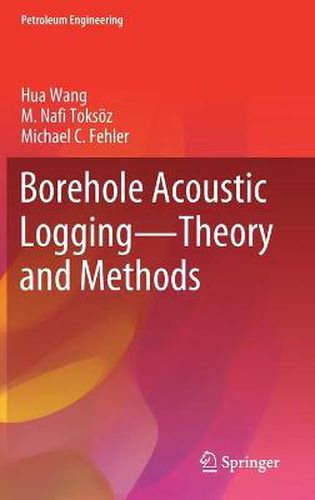Readings Newsletter
Become a Readings Member to make your shopping experience even easier.
Sign in or sign up for free!
You’re not far away from qualifying for FREE standard shipping within Australia
You’ve qualified for FREE standard shipping within Australia
The cart is loading…






This title is printed to order. This book may have been self-published. If so, we cannot guarantee the quality of the content. In the main most books will have gone through the editing process however some may not. We therefore suggest that you be aware of this before ordering this book. If in doubt check either the author or publisher’s details as we are unable to accept any returns unless they are faulty. Please contact us if you have any questions.
This book covers the principles, historical development, and applications of many acoustic logging methods, including acoustic logging-while-drilling and cased-hole logging methods. Benefiting from the rapid development of information technology, the subsurface energy resource industry is moving toward data integration to increase the efficiency of decision making through the use of advanced big data and artificial intelligence technologies, such as machine/deep learning. However, wellbore failure may happen if evaluations of risk and infrastructure are made using data mining methods without a complete understanding of the physics of borehole measurements. Processed results from borehole acoustic logging will constitute part of the input data used for data integration. Therefore, to successfully employ modern techniques for data assimilation and analysis, one must fully understand the complexity of wave mode propagation, how such propagation is influenced by the well, and the materials placed within the well (i.e., the cement, casing, and drill strings), and ultimately how waves penetrate into and are influenced by geological formations.
State-of-the-art simulation methods, such as the discrete wavenumber integration method (DWM) and the finite difference method (FDM), are introduced to tackle the numerical challenges associated with models containing large material contrasts, such as the contrasts between borehole fluids and steel casings. Waveforms and pressure snapshots are shown to help the reader understand the wavefields under various conditions. Advanced data processing methods, including velocity analyses within the time and frequency domains, are utilized to extract the velocities of different modes. Furthermore, the authors discuss how various formation parameters influence the waveforms recorded in the borehole and describe the principles of both existing and potential tool designs and data acquisition schemes.
This book greatly benefits from the research and knowledge generated over four decades at the Earth Resources Laboratory (ERL) of the Massachusetts Institute of Technology (MIT) under its acoustic logging program.
Given its scope, the book is of interest to geophysicists (including borehole geophysicists and seismologists), petrophysicists, and petroleum engineers who are interested in formation evaluation and cementation conditions. In addition, this book is of interest to researchers in the acoustic sciences and to 4th-year undergraduate and postgraduate students in the areas of geophysics and acoustical physics.
$9.00 standard shipping within Australia
FREE standard shipping within Australia for orders over $100.00
Express & International shipping calculated at checkout
This title is printed to order. This book may have been self-published. If so, we cannot guarantee the quality of the content. In the main most books will have gone through the editing process however some may not. We therefore suggest that you be aware of this before ordering this book. If in doubt check either the author or publisher’s details as we are unable to accept any returns unless they are faulty. Please contact us if you have any questions.
This book covers the principles, historical development, and applications of many acoustic logging methods, including acoustic logging-while-drilling and cased-hole logging methods. Benefiting from the rapid development of information technology, the subsurface energy resource industry is moving toward data integration to increase the efficiency of decision making through the use of advanced big data and artificial intelligence technologies, such as machine/deep learning. However, wellbore failure may happen if evaluations of risk and infrastructure are made using data mining methods without a complete understanding of the physics of borehole measurements. Processed results from borehole acoustic logging will constitute part of the input data used for data integration. Therefore, to successfully employ modern techniques for data assimilation and analysis, one must fully understand the complexity of wave mode propagation, how such propagation is influenced by the well, and the materials placed within the well (i.e., the cement, casing, and drill strings), and ultimately how waves penetrate into and are influenced by geological formations.
State-of-the-art simulation methods, such as the discrete wavenumber integration method (DWM) and the finite difference method (FDM), are introduced to tackle the numerical challenges associated with models containing large material contrasts, such as the contrasts between borehole fluids and steel casings. Waveforms and pressure snapshots are shown to help the reader understand the wavefields under various conditions. Advanced data processing methods, including velocity analyses within the time and frequency domains, are utilized to extract the velocities of different modes. Furthermore, the authors discuss how various formation parameters influence the waveforms recorded in the borehole and describe the principles of both existing and potential tool designs and data acquisition schemes.
This book greatly benefits from the research and knowledge generated over four decades at the Earth Resources Laboratory (ERL) of the Massachusetts Institute of Technology (MIT) under its acoustic logging program.
Given its scope, the book is of interest to geophysicists (including borehole geophysicists and seismologists), petrophysicists, and petroleum engineers who are interested in formation evaluation and cementation conditions. In addition, this book is of interest to researchers in the acoustic sciences and to 4th-year undergraduate and postgraduate students in the areas of geophysics and acoustical physics.